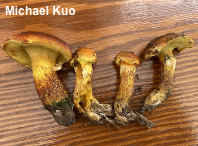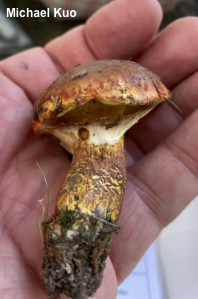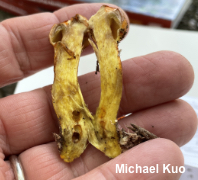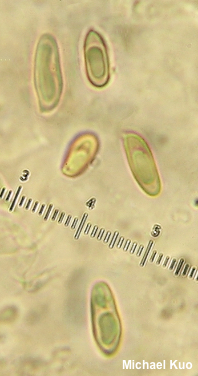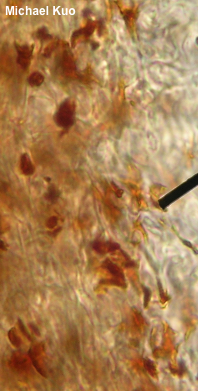| Major Groups > Boletes > Suillus > Suillus clintonianus |

|
Suillus clintonianus [ Basidiomycota > Boletales > Suillaceae > Suillus . . . ] by Michael Kuo Probably featured in your North American field guide as "Suillus grevillei," this easily recognized species of Suillus is found where its mycorrhizal partners, larch trees like tamarack and western larch, occur. It features a brownish red cap, a yellow pore surface composed of fairly small pores that are not elongated and radially arranged, a yellowish and gelatinizing ring on the stem, and yellow flesh. DNA-based research by Nguyen and collaborators (2016) supported the hypothesis of earlier researchers (Korhonen et al. 1993) who suggested that Suillus grevillei and Suillus clintonianus can be separated by their ranges (Suillus grevillei is primarily European), cap colors (yellow for Suillus grevillei), spore sizes (larger, on average, for Suillus clintonianus) and pileipellis (full of reddish brown pigment globules in Suillus clintonianus). However, Suillus grevillei does appear in North America, as the phylogram of Nguyen and collaborators (p. 1220) demonstrates—so the authors' wording, "[w]e propose usage of . . . S. clintonianus in the place of the North American S. grevillei" (p. 1224), is a bit misleading, and might be revised to something like: Suillus clintonianus is the most appropriate name for the red-capped, larger-spored, pigment-globule-manifesting, most common North American grevillei-like species, found primarily under native larches. Suillus clintonianus is also present in Asia, and in a few places in Scandinavia (primarily Finland), where it has apparently traveled with imported ornamental Asian larch trees. Records from temperate Europe probably represent misidentifications of Suillus grevillei. In case you're wondering, the Mycologese ending –ianus (along with Thanks to Fluff Berger for collecting Suillus clintonianus for study; her collection is deposited in The Herbarium of Michael Kuo. Description: Ecology: Mycorrhizal with tamarack, western larch, and Asian larch species; growing alone or gregariously; terrestrial; late summer and fall; originally described from upstate New York; widespread in North America throughout the natural ranges of tamarack and western larch; also distributed in Asia, and in Scandinavia (see comments above). The illustrated and described collections are from Ohio and Pennsylvania. Cap: 4–10 cm across; convex becoming broadly convex; sticky when fresh; bald; color variable but usually reddish brown to brownish red overall, with a yellow margin—but not infrequently yellow to orangish yellow overall when young or even at maturity; the margin sometimes hung with partial veil remnants. Pore Surface: Yellow; bruising brown to reddish brown; sometimes running down the stem; 1–2 angular pores per mm, not boletinoid in arrangement; tubes to about 10 mm deep. Stem: 4–10 cm long; 1–2 cm thick; more or less equal, above a tapered base; yellow and often reticulate above the ring; reddish brown and scurfy below; ring pale yellow to nearly whitish, collapsing; basal mycelium pale yellow to whitish. Flesh: Yellow; unchanging when sliced, or turning slightly greenish, then brownish. Odor and Taste: Not distinctive. Chemical Reactions: Not tested on the described and illustrated specimens; reported by Grund & Harrrison (1976) as follows: KOH greenish black on cap, pink to bluish on flesh; ammonia dark green to olive black on cap, red to pink, becoming bluish on flesh; iron salts olive to black on flesh. Spore Print: Yellowish brown to cinnamon. Microscopic Features: Spores 7–12 x 3–4.5 µm; subfusiform; smooth; dull golden in KOH. Basidia 20–27 x 4–5 µm; subclavate; 4-sterigmate. Cystidia 30–45 x 5–6 µm; subcylindric, with subclavate apices; thin-walled; orange-brown to brownish in KOH; in bundles; becoming gelatinized and poorly defined individually. Pileipellis an ixocutis; reddish brown pigment globules abundant; elements 2–5 µm wide, smooth or encrusted with pigment globules, hyaline to brown in water and in KOH. Clamp connections not found. REFERENCES: (C. H. Peck, 1872) O. Kuntze, 1898. (Smith & Thiers, 1964; Snell & Dick, 1970; Smith & Thiers, 1971; Grund & Harrison, 1976; Smith, Smith & Weber, 1981; Arora, 1986; Phillips, 1991/2005; Schalkwijk-Barendsen, 1991; Lincoff, 1992; Both, 1993; Korhonen et al., 1993; Bessette et al., 2002; Roody, 2003; McNeil, 2006; Miller & Miller, 2006; Klofac, 2013; Bessette et al., 2016; Nguyen et al., 2016; Baroni, 2017; Sturgeon, 2018; Læssøe & Petersen, 2019.) Herb. Kuo 09182103. This site contains no information about the edibility or toxicity of mushrooms. |
© MushroomExpert.Com |
|
Cite this page as: Kuo, M. (2022, March). Suillus clintonianus. Retrieved from the MushroomExpert.Com Web site: http://www.mushroomexpert.com/suillus_clintonianus.html |
